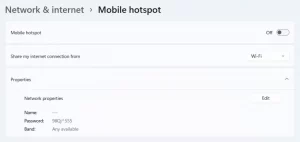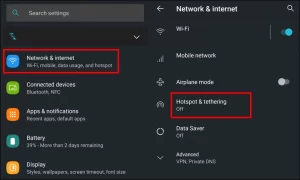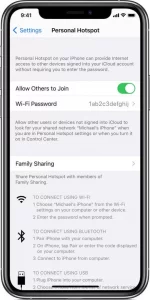Internet Connection Sharing
Comprehensive Internet network security training
To provide a safe platform for users in computer Internet networks, the network technician must be familiar with the types of networks, network goals, common methods of hackers to attack networks, and other network-related issues. To work in network security – in today’s highly competitive market – you must acquire sufficient knowledge and experience. Participating in various courses gives you everything you need about network security.
LAN network; A platform for Internet sharing
One of the platforms for implementing Internet sharing technologies is the LAN network. LAN stands for local area network. This network is a computer network that covers a relatively small area. A LAN is often limited to a single room, building, or group of buildings. Of course, the LAN network can be connected to other local networks at any distance through telephone lines and radio waves.
A system of local area networks connected is called a wide area network (WAN). WAN stands for wide area network. A LAN and a WAN are that wide area network covers a relatively large geographical area. Typically, a WAN consists of two or more local area networks (LANs).
NAT technology; One of the essentials of computer sharing Internet
NAT technology is an Internet standard that enables a local area network (LAN) to use one set of IP addresses for internal traffic and another set of addresses for external traffic. NAT stands for “Network Address Translation.” The NAT process relies on a device such as a router or a modem to do all the IP address translation where the LAN connects to the Internet. Some advantages and facilities that NAT provides to users are:
- Create a kind of firewall by hiding internal IP addresses
- Use more internal IP addresses in companies
- Ability to merge multiple ISDN Internet connections to create a single Internet connection
- Preventing the risk of external interference with addresses used by other companies or organizations through internal use of IP addresses
The types of NAT technology are also:
- Dynamic NAT: The process of translating private IP addresses to public IP addresses in a specific range is called NAT pool.
- Static NAT: Static NAT refers to the process of translating private IP addresses one-to-one to the same public IP address
- Overloading: Overloading technology is sometimes called “Port Address Translation (PAT)” or “Single Address” NAT; Overloading is a version of dynamic NAT where all private IP addresses are translated to the same public IP address using different ports.
- Overlapping: Overlapping occurs when private IP addresses on an internal network are identical to addresses on an external network; This means that the NAT router must have a lookup table to compare the two and translate accordingly.
DSL technology; A group of cable internet connection technologies
The term DSL refers to all types of digital subscriber lines. Its two famous and widely used technologies are ADSL and SDSL. Two other types of this group of Internet connection technologies that are less commonly used are:
- HDSL or High-data-rate DSL means DSL with a high data rate
- VDSL or Very High DSL or very high DSL
DSL technologies package and transmit data over copper wires using complex modulation schemes. They are sometimes referred to as “last mile” technologies because they are only used to connect from a telephone switching station to a home or office, not between switching stations.
DSL technology is very similar to ISDN in that both operate over existing copper telephone lines (POTS) and require a central telephone office. However, DSL offers much higher speeds, Up to 32 Mbps for upstream traffic and from 32 kbps to more than 1 Mbps for downstream traffic.
ADSL technology
ADSL stands for Asymmetric Digital Subscriber Line. ADSL is a DSL broadband communication technology used to connect to the Internet. ADSL allows more data to be sent over existing copper telephone lines (POTS) than traditional modem lines. A microfilter, a special filter, is installed on the shared telephone line to use ADSL Internet and regular telephone line services simultaneously.
ADSL technology requires a special ADSL modem, and subscribers must be in geographical locations close to the service provider’s headquarters to receive ADSL service. ADSL supports data exchange speeds from 1.5 to 9 Mbps when receiving data or downloading (known as the downstream rate) and from 16 to 640 kbps when sending data or uploading (known as the upstream rate).
Many Internet users who use the ADSL connection model have concerns about the security of their information in this method;
SDSL technology
SDSL stands for Symmetric Digital Subscriber Line. SDSL technology allows more data to be sent over existing copper telephone lines (POTS). SDSL supports data transfer speeds up to 3 Mbps.
SDSL works by sending digital pulses in the high-frequency region of telephone wires; For this reason, we cannot use the cable lines used for SDSL simultaneously for normal telephone services and making phone calls. SDSL technology requires a special modem for SDSL connection. The symmetric adjective in the term SDSL is because the technology supports the same data rate for upstream and downstream traffic, or download and upload. ADSL technology is more popular in North America, while SDSL is generally used in Europe.
ISDN technology; Traditional but still functional
The term ISDN stands for Integrated Services Digital Network. ISDN is a set of communications standards that use the digital transmission to carry telephone calls, video calls, data transmission, and other network services over traditional PSTN circuits in public switched telephone networks.
The life of the standardization of these services is the same as the life of the invention of the telephone. The starting point of this technology can be considered the research laboratory of Graham Bell. ISDN is also used to connect and share an Internet connection. Also, video conferencing using this technology can be mentioned among its other successful applications. Suppose you are interested in learning about the methods of converting traditional technologies and old computers to modern technology. In that case, we suggest you participate in the file server familiarization course and convert an old home computer to a file server through the following link:
Dial-Up Internet Connection
Dial-Up technology is an old technology for connecting to the Internet and dividing this connection between two or more computers. It refers to connecting the device to the network through a modem and public telephone network. Dial-up access is just like a telephone connection, except that the parties to this connection are computer devices. Since Dial-Up access uses regular phone lines, connection quality is not always good, and data rates are limited. The maximum data speed accessed through a dial-up Internet connection is 56 kbps, but new technologies such as ISDN offer faster rates.
An alternative way to connect two computers using Dial-Up technology is to connect through a leased line, which creates a permanent connection between the two devices. A leased line is a permanent telephone connection between two points established by a common telecommunications carrier. Typically, leased lines are used by businesses to connect offices that are geographically far apart. Leased lines offer faster throughput and better quality connections, but they cost more.
Satellite Internet connection technology
Satellite Internet access is a technology in which input and output data or download and upload are transferred between a computer and a satellite. The hardware of each satellite Internet connection service subscriber includes a satellite dish antenna and a transmitter/receiver that operates in the microwave portion of the radio spectrum.
Speed of information exchange in satellite internet connection
In a two-way satellite Internet connection, upstream data is usually sent at a lower speed than downstream data. Therefore, the connection in this technology is an asymmetric connection type. Uplink speed for a computer subscriber is around 50 to 150 kbps. Depending on factors such as internet traffic, server capacity, and the size of downloaded files, downstream connection speeds of around 150 kbps to over 1200 kbps are also possible.
Advantages and disadvantages of satellite Internet sharing
Satellite Internet systems are an excellent but expensive option for people in rural areas where digital subscriber line (DSL) and cable modem connections are unavailable. Suppose there is a generator or battery power source that can produce enough electricity to run a desktop computer system. In that case, this technology can be used even in places without the most basic amenities.
The two-way satellite Internet option provides an always-on, continuous connection that bypasses the Dial-Up process. In this sense, the satellite internet connection system is similar to a cable modem. But this technology is also associated with risks in the field of information hacking; Unless a firewall is used to protect the computer from hacking attempts.
Internet sharing cable
Internet sharing cable or Share Internet Over Ethernet Cable is a general term for any Internet network connection and sharing. When many people hear about the possibility of connecting to the Internet through wires, they think of technologies such as ADSL, which uses the network of telephone cables. But cable internet sharing is not limited to this network; fiber optic networks and cable TV networks can also be used for it.
Tethering technology; From mobile internet sharing technologies
Tethering is the act of using a mobile phone or tablet as a modem to connect another device such as a laptop or another mobile phone to the Internet. To do this, the host and guest devices must be synced or linked, and the host device must be connected to the Internet to share this connection.
Tethering has various advantages and uses, and in many cases, it is used as an alternative or complementary method or when purchased Internet packages expire. Also, you can share it with one or more mobile phones or other guest devices by purchasing an affordable internet package and activating it on a mobile phone. In the following, we will get to know some types of tethering.
Tethering via Bluetooth
Bluetooth tethering is one of the ways to share the wireless connection of a mobile phone or tablet with another device using Bluetooth technology. In this method, like WiFi tethering, you can connect multiple devices wirelessly to your smartphone.
Tethering via WiFi
WiFi tethering is used to broadcast your mobile phone signal as a WiFi network, then connect your laptop or any other WiFi-enabled device to it to connect to the Internet. It is sometimes referred to as a mobile hotspot, personal hotspot, portable hotspot, or WiFi hotspot. Keep in mind that both WiFi and Bluetooth internet sharing models are based on a wireless network, and it is important to be aware of network safety points. For complete training in this field, we recommend this training course:
router; One of the devices for creating internet sharing functionality
A router is a device that connects two or more packet-switched networks or subnets for Internet sharing and other purposes. A router has two main functions: managing traffic between these networks by sending data packets to their intended IP addresses and allowing multiple devices to use the same Internet connection.
A router connects your devices to the modem in a wired connection setup. The router connects via an Ethernet cable, or in the case of a wireless router, a WiFi signal, to the modem and then to your devices, including laptops, smart TVs, and printers. A router creates a local area network (LAN) in your home or office environment and allows your devices to share files.
Creation of Internet sharing capability.
The router manages all the data going to and from each device and the modem, ensuring it gets safely to the right exchange point. However, the router does not most note for the modem to function. You can create a LAN without internet access. Simply put, your router:
- Assigns a local IP address to each device on the network
- Creates a firewall to prevent security breaches
- Manages your network traffic
- Enables any parental control and lack of access
The number of routers required in LAN and WAN networks
There are many different tuners, but most routers transfer data between LANs (local area networks) and WANs (wide area networks). A LAN is a group of connected devices limited to a specific geographic area, so a local area network or LAN usually requires a router (and no more).
In contrast, a WAN is a large network spread over a large geographical area. For example, large organizations and companies that operate in several locations across the country need separate local area networks for each location and at least one router in each. If you are interested in getting to know all kinds of computer networks, we suggest you participate in this training course:
modem; A tool that brings the Internet to your home
A modem is a device that connects your home to an Internet Service Provider (ISP), usually via a coaxial cable. The modem takes signals from your ISP and converts them into signals that your local devices can use and vice versa. The connection between your home and the Internet is known as a wide area network (WAN). Each modem is assigned a public IP address that identifies it on the Internet.
How to do Internet sharing in Windows
Just follow the steps below to share your Internet connection in Windows with other users.
The first stage
Press Windows key + X on your keyboard to open the Power User settings menu and select Network Connections.

The second stage
After you select the Network Connections option, a window similar to the image below will open for you, where you must select the Mobile Hotspot option:

third level
After you select the Mobile Hotspot option, the Internet Sharing settings will be displayed to you, where you can choose the connection type, password (if you choose the WiFi option), and your network name on this page:

By following these steps, you can share your Internet with other devices (laptop, mobile, or tablet) and use your internet connection on other devices without needing to establish a separate internet connection for your other devices.
How to do Internet sharing on Android devices
To share your internet connection on Android devices, just go to your device’s settings and look for the option Network and Internet among the options. Then on the page that opens in the Hotspot section, click the option to activate. Also, by entering the menu In this section, you can assign a name and password for your internet subscription so that any gadgetwith a gadget can use your Internet.

How to do internet sharing on iOS devices
For Internet sharing on iOS devices, you must enter the following section in the settings:
To face a page similar to the image below:

On this page, by enabling the Allow others to join option and setting youseted password, you can share your Internet connection via WiFi with other devices around you.
Internet sharing; A collection of traditional and modern technologies
Internet sharing is a broad topic that includes various communication fields, computer science, network knowledge, and digital devices. The scope of this topic is from traditional technologies such as Dial-p to the most up-to-date technologies and devices for connecting to the global Internet network such as: Satelite Internet. Knowledge of these technologies allows us to choose the best Internet connection model and Internet connection subscription for business or various other activities, according to the needs of these activities and the facilities and benefits of these models.











